
Espresso beans and regular coffee beans differ significantly in their roasting, flavor, and grind size, which directly influences the coffee’s final taste and quality. Espresso beans are typically roasted longer, resulting in a darker roast than regular coffee beans. This darker roast contributes to espresso’s characteristically bold, rich flavor with a pronounced bitterness.
The grind size for espresso beans is also much finer compared to the coarser grinds used for regular coffee. This fine grind is crucial for espresso extraction, allowing hot water to quickly pass through the coffee under high pressure and extract a concentrated, flavorful shot of coffee.
Can You Use Espresso Beans to Make Regular Coffee?
Contrary to common misconceptions, espresso beans can be used to make regular coffee. The primary difference between espresso and regular coffee lies in the brewing method and equipment, not the beans themselves. While espresso is made by forcing hot water through tightly packed, finely ground coffee at high pressure, regular coffee brewing methods like drip, pour-over, or French press use coarser grinds and involve a slower, gravity-fed water passage through the grounds.
Using espresso beans for regular coffee may result in a brew with a more intense flavor and thicker body, appealing to those who prefer a robust cup. However, it’s crucial to adjust grind size and brewing technique accordingly to achieve a balanced extraction.
Brewing Methods Using Espresso Beans
Making Drip Coffee With Espresso Beans
Using espresso beans to brew drip coffee introduces a distinct texture and flavor profile compared to regular drip coffee beans. Espresso beans, known for their darker roast, contribute to a coffee with a stronger, more robust flavor and a thicker mouthfeel. This intensity stems from the fine grind and concentrated flavors of espresso beans, which, when used in a drip coffee maker, can result in a cup that is bold and rich, with a pronounced presence on the palate.
Adjusting the grind size is crucial when using espresso beans for drip coffee. A slightly coarser grind than that used for espresso machines can prevent over-extraction and bitterness. Experimenting with the brewing method can also lead to a more espresso-like brew.
For example, a shorter extraction time or adjusting the water temperature can help in achieving a balance between the espresso beans’ inherent robustness and the milder extraction typical of drip coffee. This approach allows coffee enthusiasts to enjoy a cup that bridges the gap between the intense espresso and the traditional drip coffee experience.
Pour Over Coffee With Espresso Beans
Pour-over coffee made with espresso beans requires careful attention to detail to harness the beans’ full potential. The equipment needed for this method includes a pour-over coffee maker (like Chemex or Hario V60), a coffee grinder, a gooseneck kettle for precise water flow, and a scale for accurate measurement.
- Grind the Espresso Beans: Aim for a medium-fine grind, slightly coarser than for an espresso machine but finer than for standard pour-over coffee. This grind size ensures proper extraction without over-extracting the bitter components.
- Prepare the Pour-Over Setup: Place the filter in the brewer and rinse it with hot water to remove any paper taste and preheat the brewer.
- Brewing Process: Measure the coffee and water using a 1:16 ratio, one part coffee to sixteen parts water. Begin by wetting the grounds with a small amount of hot water (around 200°F) to allow them to “bloom,” releasing CO2. Continue pouring the water in a slow, circular motion, ensuring an even saturation of the grounds.
The impact on flavor and extraction when using espresso beans in pour-over coffee is significant. The pour-over method highlights the beans’ rich, complex flavors, while the controlled brewing process allows for a nuanced extraction. The result is a cup that combines the depth and intensity of espresso with the clean, delicate profile of pour-over coffee.
Cold Brew Coffee With Espresso Beans
Cold brew coffee made with espresso beans offers a unique twist on the traditional cold brew method. The process involves steeping coarsely ground espresso beans in cold water for an extended period, typically 12 to 24 hours, which produces a smooth, rich coffee concentrate. For a traditional cold brew:
- Coffee to Water Ratio: Start with a 1:8 ratio of coffee to water for a balanced extraction.
- Grinding the Beans: Grind the espresso beans coarsely, similar to the consistency for French press coffee.
- Steeping: Combine the ground coffee and cold water in a large container, stirring gently to ensure all the grounds are saturated. Cover and let it steep in the refrigerator.
- Straining: After steeping, strain the brew through a fine-mesh sieve or cheesecloth to remove the grounds. The result is a concentrated cold brew that can be diluted with water or milk to taste.
An alternative method, the Japanese flash cold brew, involves pouring hot water over espresso grounds and allowing the coffee to drip directly over ice. This method extracts the espresso beans’ flavors quickly, resulting in a cold brew that is bold and refreshing yet less acidic than traditional methods. The ideal coffee to water ratio for this method is more concentrated, around 1:4, to compensate for the dilution from the melting ice.
French Press and Espresso Beans
Using espresso beans in a French press can elevate your coffee experience with a more intense flavor profile. The process is straightforward:
- Grind the Beans: Espresso beans should be ground coarsely to match the French press brewing method.
- Proportions: Use a 1:12 ratio of coffee to water.
- Brewing Time: After adding hot water to the grounds, let the brew steep for about 4 minutes.
- Plunging: Press the plunger down slowly to separate the grounds from the liquid.
The expected taste profile is a rich, full-bodied coffee with a profound depth of flavor, capturing the espresso beans’ robust characteristics without the bitterness.
Espresso Machine: Achieving the Best Results
For those seeking coffee shop quality at home, using espresso-specific beans with an espresso machine is essential. These beans are typically darker roasts, providing the bold flavor and crema that espresso is known for. The best results are achieved with fresh, high-quality beans ground just before brewing to preserve flavor and aroma.
Some of the top recommended beans include Arabica blends with notes of cocoa and cherry, emphasizing the beans’ freshness and roast level to ensure the perfect espresso shot.
FAQs
Is Espresso Stronger Than Coffee?
While espresso has a more concentrated flavor and higher caffeine content per ounce, a standard cup of coffee actually contains more total caffeine. This is due to the larger serving size of coffee compared to a single espresso shot.
Can Any Coffee Bean Be Used for Espresso?
Technically, any coffee bean can be used to make espresso. However, for authentic espresso with the right flavor profile and crema, using beans specifically roasted for espresso is recommended. The choice of bean affects the espresso’s quality, underscoring the importance of selecting the right roast and blend.
How Does Bean Roast Affect Espresso and Coffee Flavor?
The roast level of the beans significantly influences the taste of the resulting coffee or espresso. Darker roasts, often used for espresso, impart a bold, robust flavor with potential notes of chocolate and caramel. Lighter roasts, on the other hand, tend to produce coffee with brighter acidity and lighter body, highlighting floral and fruity notes.
Adjusting Brew Methods for Espresso Beans
When using espresso beans for regular coffee making, adjusting the grind size and brewing method is crucial. A slightly coarser grind than that used for espresso machines is ideal for drip or pour-over methods, preventing over-extraction. Experimentation with water temperature and brewing time can help in achieving a balanced cup that leverages the espresso beans’ intensity while maintaining the desired flavor profile.
Final Thoughts
The exploration of using espresso beans across various brewing methods reveals a remarkable versatility that caters to diverse taste preferences. Whether seeking the intensity of a traditional espresso, the richness of a French press, or the nuanced extraction of pour-over and cold brew, espresso beans offer a foundation for experimentation and discovery.
Encouraging coffee enthusiasts to experiment with grind sizes, brewing times, and methods, this journey underscores the importance of personal taste and the endless possibilities within the realm of coffee brewing.









